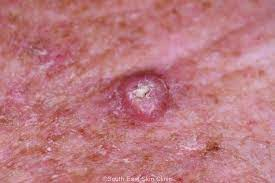May begin as solar (actinic) keratosis or be found on the lips of smokers or long standing ulcers (Marjolin’s ulcer)
While it tends to grow more quickly than Basal Cell Carcinoma, it is still generally slow-growing and has a low risk of metastasis.

Causes/Factors
The primary cause of Squamous Cell Carcinoma is prolonged exposure to ultraviolet (UV) radiation from the sun or tanning beds. Other risk factors include:
- Fair Skin: Light-skinned individuals are more susceptible.
- Chronic Sun Exposure: Especially without adequate sun protection.
- Previous Skin Injuries: Such as burns, scars, or chronic ulcers.
- Weakened Immune System: Due to conditions or medications.
- Human Papillomavirus (HPV) Infection: In some cases, SCC may be associated with certain strains of HPV.
Symptoms
- Skin Changes: A persistent, red, scaly patch, a firm, raised nodule, or a wart-like growth.
- Open Sores: Sores that don’t heal or continuously come back.
- Bleeding: Lesions that bleed or ooze.
Diagnostic Tests
- Referral to a dermatologist for input
- Skin biopsy
Management
- Excision
- Radiotherapy for recurrence/affected nodes
Complications/red Flags
- Metastasis: While less common than with Melanoma, SCC can metastasize, particularly if left untreated.
- Local Tissue Damage: Invasion of surrounding tissues and structures.
- Recurrence: SCCs may recur, especially if not completely removed.